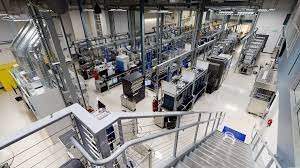
source: Emerald Cloud Lab
Given the right task, AI-driven machines can be empowered with supercharged IQs that make the smartest humans look dumb, or at least inefficient. As we watch advances made in task automation, we see it burgeoning into fields previously (last week) thought unimaginable.
Two recent reports underline the trend. In one, Carnegie Mellon University is teaming with San Francisco-based Emerald Cloud Lab (ECL) to build an automated laboratory for scientific experimentation. In another, from Google, AI is being used to automate the design of microprocessors, including those used at the convergence of HPC and AI.
Let’s start with Carnegie Mellon. A recently published blog on the CMU site states that life science and chemistry researchers will be provided with what the university calls the world’s first cloud lab in an academic setting. “The remote-controlled lab will provide a universal platform for artificial intelligence-driven experimentation and revolutionize how academic laboratory research and education are done,” CMU said, “accelerating the pace of discovery as part of Carnegie Mellon’s $250 million investment in state-of-the-art science facilities.”
The lab will be based on the commercial cloud lab platform created by ECL, which was founded by Carnegie Mellon alumni Brian Frezza and DJ Kleinbaum and claims to be the only remotely operated research facility that can handle a range of daily lab work, from experiment design to data analysis.
The $40 million project is expected to begin this fall and be finished next summer. CMU said the facility will house more than 100 types of scientific instruments for life sciences and chemistry experiments and will be able to run more than 100 experiments simultaneously, processing them 24/7/365.

“The ECL platform enables researchers to direct experiments online, inputting their parameters using a command-based system with the assistance of AI-driven design tools — all they need is access to a computer and internet connection,” CMU said. “In the lab, a combination of robotic instrumentation and trained operations personnel perform experiments exactly as specified by the researchers’ instructions. The resulting data is sent to cloud-based servers where scientists can access it at any time. Since all data generated in the cloud is organized and connected to the set of experimental commands that were used to generate it, data is accessible, shareable and push-button reproducible.”
Meanwhile, Wall Street Journal subsidiary Marketwatch has published an article by business publisher, consultant and designer Jurica Dujmovic reporting that computer chips have evolved to the degree that the use of AI in their design has become mandatory.
“Until now, chip design has been the domain of electrical engineers,” Dujmovic wrote, “but a recent Google study could change that. It showed that the AI-created chip layout was ‘superior or comparable to those produced by humans in all key metrics, including power consumption, performance, and chip area.’ Thanks to a machine-learning technique known as reinforcement learning, artificial intelligence completed the task in only six hours, compared with weeks by humans.”
In its study, the Google research team said: “Despite five decades of research1, chip floorplanning has defied automation, requiring months of intense effort by physical design engineers to produce manufacturable layouts,” stating that its deep reinforcement learning approach “automatically generates chip floorplans that are superior or comparable to those produced by humans in all key metrics, including power consumption, performance and chip area.”
Google isn’t alone in AI-based chip design activity. Dujmovic cited Nvidia as testing AI-powered techniques and said that Samsung used software from Synopsys, a chip design software company, to design Exynos, a processor used in Samsung’s wearables, smartphones, car infotainment systems, among other products.
 Not surprisingly, the process of AI training involved in chip design is arduous, but Synopsys said in a blog that the effort is worth it: a “North American integrated device manufacturer was able to achieve up to 15 percent better total power, 30 percent better leakage, and two to five times faster convergence using DSO.ai (Synopsys algorithm) — all with a single engineer, in just weeks.”
Not surprisingly, the process of AI training involved in chip design is arduous, but Synopsys said in a blog that the effort is worth it: a “North American integrated device manufacturer was able to achieve up to 15 percent better total power, 30 percent better leakage, and two to five times faster convergence using DSO.ai (Synopsys algorithm) — all with a single engineer, in just weeks.”
Does all this jeopardize career opportunities for electrical engineers and chip designers? No. Dujmovic opines that the size of advanced chips and their design teams have grown so large that “it has become impossible to scale further without jeopardizing business sustainability. Getting the AI involved doesn’t necessarily mean that developers will become obsolete all of a sudden. Algorithms optimize the workflow and accelerate time-intensive parts of the design process, so that designers can focus on making crucial calls that require higher-level decision making.”



